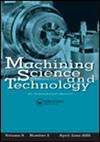Cryogenic machining of elastomers: a review
IF 2.6
4区 工程技术
Q2 ENGINEERING, MANUFACTURING
引用次数: 6
Abstract
Abstract Elastomers have visco-elastic behavior and are widely used in general utility as well as sophisticated applications. Generally, elastomer components are produced by molding process. But it is not economical for complicated geometrical elastomeric components of small batch size. Hence, machining is an alternative method of the molding. However, high elasticity, low Young’s modulus and low thermal conductivity in addition to the difficulty of holding elastomer component hinder its machining. To address these challenges, in last two decades, cryogenic assisted milling/turning, cryogenic abrasive jet micromachining (CAJM), ultra-high-pressure water jet machining and low-power CO2 laser cutting were reported and noticed that both machining parameters and cryogenic condition affect the quality of the end-product. The structure-property changes on the surface of elastomer due to cryogenic condition helps in improvement of cutting force, erosion rate, chip formation, surface morphology, and reduction in the abrasive particle embedding at the machined surface. In addition to this, cryogenic assisted machining is a safe environmental alternative approach and it reduces the possibility of abrasive contamination at the machined surface. Hence, this article makes a comprehensive review of developments in elastomer machining over the last two decades and discusses the pros and cons of the same.弹性体的低温加工:综述
弹性体具有粘弹性,广泛应用于一般用途和复杂用途。通常,弹性体部件是通过成型工艺生产的。但对于几何形状复杂、批量小的弹性体部件,这种方法并不经济。因此,机加工是成型的一种替代方法。然而,弹性体部件的高弹性、低杨氏模量和低导热系数以及不易保持等缺点阻碍了弹性体部件的加工。为了应对这些挑战,近二十年来,人们报道了低温辅助铣削/车削、低温磨料射流微加工(CAJM)、超高压水射流加工和低功率CO2激光切割,并注意到加工参数和低温条件都会影响最终产品的质量。低温条件下弹性体表面结构性能的变化有助于提高切削力、切削速率、切屑形成和表面形貌,并减少在加工表面的磨粒包埋。除此之外,低温辅助加工是一种安全环保的替代方法,它减少了加工表面磨料污染的可能性。因此,本文全面回顾了过去二十年来弹性体加工的发展,并讨论了其优缺点。
本文章由计算机程序翻译,如有差异,请以英文原文为准。
求助全文
约1分钟内获得全文
求助全文
来源期刊

Machining Science and Technology
工程技术-材料科学:综合
CiteScore
5.70
自引率
3.70%
发文量
18
审稿时长
6 months
期刊介绍:
Machining Science and Technology publishes original scientific and technical papers and review articles on topics related to traditional and nontraditional machining processes performed on all materials—metals and advanced alloys, polymers, ceramics, composites, and biomaterials.
Topics covered include:
-machining performance of all materials, including lightweight materials-
coated and special cutting tools: design and machining performance evaluation-
predictive models for machining performance and optimization, including machining dynamics-
measurement and analysis of machined surfaces-
sustainable machining: dry, near-dry, or Minimum Quantity Lubrication (MQL) and cryogenic machining processes
precision and micro/nano machining-
design and implementation of in-process sensors for monitoring and control of machining performance-
surface integrity in machining processes, including detection and characterization of machining damage-
new and advanced abrasive machining processes: design and performance analysis-
cutting fluids and special coolants/lubricants-
nontraditional and hybrid machining processes, including EDM, ECM, laser and plasma-assisted machining, waterjet and abrasive waterjet machining
 求助内容:
求助内容: 应助结果提醒方式:
应助结果提醒方式:


